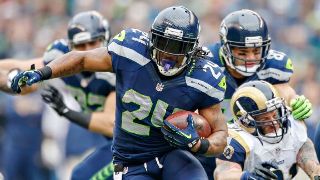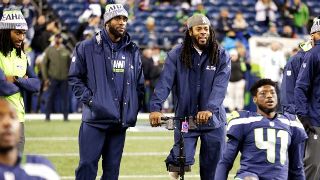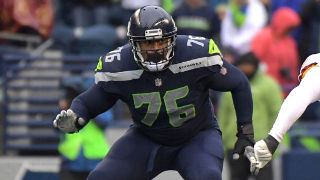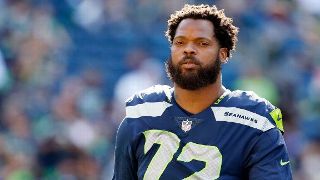|
The future seemed limitless for the Seattle Seahawks back on Feb. 3, 2014. The previous evening, they had hammered the Denver Broncos 43-8 to win Super Bowl XLVIII. They had done it with a second-year quarterback in Russell Wilson, a workhorse running back in Marshawn Lynch who was still only 27, and a defense that was brimming with young stars such as cornerback Richard Sherman, safety Earl Thomas, safety Kam Chancellor and linebacker Bobby Wagner. And if it wasn't exciting enough that the Seahawks had just won their first Super Bowl in franchise history, it felt like they were just getting started. Four years and zero championships later, there's a feeling of unfulfillment that few would have imagined the morning after that Super Bowl victory. With the Lombardi trophy at his side and his voice not all the way there after the team had partied the previous night away, coach Pete Carroll explained why the Seahawks were positioned as perfectly as any team could be to win more Super Bowl titles. "I think we are in a very fortunate situation," Carroll said. "[General manager] John Schneider has done an extraordinary job of structuring this roster contractually and with the vision of looking ahead so that we can keep our guys together. One of the things that happens so often is that teams have a big fallout after they win the Super Bowl, and we’re not in that situation." The 2012 Baltimore Ravens were the most recent example of how salary-cap constraints often make Super Bowl-winning rosters too expensive to keep intact. But the Seahawks, loaded with cost-controlled talent, were set up to delay that fate. They were good enough to dominate a Super Bowl and still young enough to conceivably make several more runs at it, putting them right in the sweet spot of the life cycle of a championship contender. Winning multiple Super Bowls in one stretch is exceedingly difficult in a league that actively strives toward parity, which makes it an accomplishment in its own right that the Seahawks came a yard away from repeating as champions in Super Bowl XLIX. Since then, though, they haven't advanced past the divisional round of the playoffs. They won 13 and 12 games during those Super Bowl seasons -- then 10 games in each of the next two. That downward trend continued in 2017 with a 9-7 finish that snapped their string of five straight playoff appearances. And now the Seahawks have entered what could be a transformative offseason in 2018. They've already fired their top four assistant coaches, including their offensive and defensive coordinators, in what has been the most significant overhaul of their coaching staff under Carroll. That could be a prelude to a substantial retooling of the roster that affects some of the most iconic players in franchise history. Disquieting times for an organization that not long ago seemed positioned for a potential dynasty. Here are seven factors, in no particular order, that led the Seahawks to where they are now -- without a title since the 2013 season -- plus the outlook for each of those factors in 2018 and beyond.  Missing Beast ModeTwo of the traits that made Lynch one of the best running backs of this era were his durability and his ability to break tackles. From 2011 to 2014, a stretch in which Lynch missed only one game, Seattle ranked second in the NFL in rushing yards after first contact, according to ESPN Stats & Information. The Seahawks ranked first in overall rushing during that span while Lynch bulldozed his way to four straight seasons with at least 1,200 yards and 11 touchdowns. The fact that Thomas Rawls led the league in yards per carry in 2015 while Lynch was sidelined for more than half the season gave promise to the possibility that Seattle's running game would be in good hands in the post-Beast Mode era. That hasn't been the case. Injuries and ineffectiveness have led to 12 different tailbacks carrying the ball for Seattle over the past two seasons; the team finished 25th in rushing in 2016 and 23rd in 2017, ranking 22nd over the two years combined. The Seahawks' inability to run the ball in 2017 put way too much of the offensive load on Wilson, who led the team in rushing by a wide margin. "We have a real formula for how we win," Carroll said. "We've been unable to incorporate a major aspect of that -- running the football the way we want. There are tremendous examples of teams around the league that have turned their fortunes around with a formula that should sound familiar to you: teams running the football, playing good defense and doing the kicking game thing. That's the formula that has proven historically the best in this game. We've been committed to that from the start but unfortunately we have not been able to recapture it the way we have in the past." Looking ahead: As much promise as Chris Carson and Mike Davis have shown, neither has been particularly durable. Rawls also has struggled with injuries and has never been the same since a broken ankle cut short his outstanding rookie season. As a restricted free agent, Rawls might not be back with Seattle next season. Don't count out the possibility of the Seahawks adding another early-down option in free agency or the draft to hedge against the injuries that have made their backfield a revolving door over the past two seasons.  A string of unfruitful draftsWhile the Seahawks used every avenue of player acquisition imaginable to build their two Super Bowl teams, the core of those rosters were several home run draft picks from 2010 to 2012, the first three seasons of the Carroll/Schneider regime. That includes: Thomas (first round), offensive tackle Russell Okung (first), Chancellor (fifth), Sherman (fifth), linebacker K.J. Wright (fourth), Wilson (third) and Wagner (second). All of those players made at least one Pro Bowl in Seattle and all but Okung are still with the team. It would be unreasonable to expect the Seahawks or any team to continue hitting on draft picks with that same level of success. It was a remarkable three-year stretch that might never be matched. Still, Seattle didn't find enough starters let alone star players in the three drafts that followed. In fact, only five players Seattle drafted from 2013 to 2015 are still with the team -- so the Seahawks have more Pro Bowlers remaining from their first three drafts than they have players period from their next three. Of that group of five, receiver Tyler Lockett was the only player to make a Pro Bowl as an original selection -- that was as a kick returner -- while center Justin Britt was named an alternate. Defensive end Frank Clark, receiver Paul Richardson and tight end Luke Willson are the others. The Seahawks parted with their first-round pick in 2013 for receiver Percy Harvin and in 2015 for tight end Jimmy Graham. Not having those selections diminished the overall impact those draft classes can have, but the Seahawks still didn't hit on enough of the picks they did have in those years. Looking ahead: While the Seahawks haven't drafted a Pro Bowl position player since 2012, their 2017 draft class has plenty of promise -- even with the uncertainty over whether their top pick, defensive tackle Malik McDowell (No. 35 overall), will ever play following a head injury. Cornerback Shaquill Griffin and guard Ethan Pocic look like long-term starters, defensive tackle Nazair Jones made an impact as a rotational player, and Carson has a good shot to be Seattle's lead running back as long as he's healthy. This year, the Seahawks have the No. 18 overall pick and no selections in the second or third rounds. They aren't projected to receive any compensatory picks and could have as few as seven selections in all, so trading their first-rounder in order to acquire more picks will carry plenty of appeal for Schneider & Co. on draft day.  Some costly misses in free agencyThough the Super Bowl teams were largely made up of their own draft picks, the Seahawks pulled off a pair of coups in 2013 when they signed defensive ends Michael Bennett and Cliff Avril on bargain deals. They stand as two of the best free-agent additions in franchise history. By the end of the 2014 season, Bennett and Avril formed a starting defensive line comprised entirely of free-agent acquisitions along with Tony McDaniel and Kevin Williams. Cornerback Brandon Browner was another excellent find -- from Canada, no less -- who helped Seattle reach its first Super Bowl. Free agency hasn't been as kind to the Seahawks since then. They whiffed badly on cornerback Cary Williams in 2015, giving him $7 million guaranteed only to cut him during his first season in Seattle, then didn't get much from offensive tackles Bradley Sowell and J'Marcus Webb after signing them to lower-cost deals in 2016. Running back Eddie Lacy and kicker Blair Walsh were both misses in 2017. In fairness, Lacy's signing didn't seem like a bad idea until he produced only 179 yards and no touchdowns after Seattle gave him almost $3 million guaranteed. And the decision to bet on Walsh over Stephen Hauschka was rooted in decent logic even though it backfired when he made only 21 of 29 field goal attempts, with several of those misses proving costly in close losses. The Seahawks had their missteps in free agency in their early years under Carroll and Schneider -- anyone remember Robert Gallery? -- but they had more of a margin for error back then than they do now with a more expensive roster. Looking ahead: Barring some significant salary dumps, the Seahawks might not have the cap room to be much more than bargain shoppers in free agency this year. Two signings from 2017 could end up paying major dividends, however. Bradley McDougald capably filled in for Chancellor, though he's again an unrestricted free agent after signing a one-year deal. Defensive end Dion Jordan, the 2013 No. 3 overall pick, turned a second chance with the Seahawks into four sacks in five games. He's a restricted free agent, so Seattle can bring him back next season on a low-cost deal.  Injuries to their most important playersThe Seahawks had some injury challenges during their Super Bowl seasons, to be sure, but when you consider who didn't get hurt, they were actually living quite well. From 2012 to 2014, Wilson, Sherman, Thomas and Lynch didn't miss a single game. That's a remarkably good run of health considering those were arguably Seattle's four best and most important players during that span. That good fortune has run out. Wilson played through knee and ankle sprains in 2016, and although he didn't miss a game, he was without the mobility that makes him a huge factor in the Seahawks' running game. Seattle's pass defense fell apart later that season when Thomas broke his leg. This past season, Sherman (Achilles) and Chancellor (neck) went down in November with season-ending injuries. Seattle went 3-4 without them, with three of those losses coming by a combined 11 points. Think a fully intact Legion of Boom could have made a difference? Add in the neck injury that ended Avril's season a month in, and the Seahawks lost three of their eight Pro Bowl players on defense in 2017. "We had some severe injuries," Wilson told ESPN's NFL Live during Super Bowl week. "When you have the caliber of players that we have and the guys that you're relying on and then they get injured, that's tough." Looking ahead: Avril's injury, like Chancellor's, is considered career-threatening. Carroll spoke ominously at season's end about their futures, saying each is "going to have a hard time playing football again" before backing off that statement a bit. Sherman had surgery to repair his right Achilles tendon and also had what Carroll described as a cleanup procedure on the same part of his left foot. He appears to have a good chance to be ready by the start of next season.  Super Bowl XLIX loss has lingeredCarroll often mentions how, win or lose, life is difficult for teams coming off a Super Bowl appearance. The Seahawks had to manage all of the attention that came with winning their first Super Bowl. Losing the Super Bowl the following season in maybe the most gut-wrenching fashion imaginable -- with an interception at the 1-yard line -- has proved especially difficult for the team to move past. Seth Wickersham's ESPN The Magazine story from last year detailed how that catastrophic ending contributed to a strain in the team's chemistry and discontent from Sherman in particular. Sherman evoked that play in December 2016 while explaining to reporters why he had gone off on Carroll and then-offensive coordinator Darrell Bevell after Wilson was nearly intercepted on another goal-line throw, this time in a win against the Rams. It was the second time that season he had lashed out against a coach on the sideline. "They are still having a hangover from two years ago, if you can believe it or not, about losing that Super Bowl in the last minute with the interception on the 1-yard line," Warren Moon, the team's radio analyst, said last June in an interview with "NFL No Huddle" on TuneIn. "And with a lot of guys, it just kind of rubbed them the wrong way and they just haven’t gotten over it. This team will not be able to move on and really do what they want to do, which is win another Super Bowl, unless they can somehow put that behind them. There are certain guys on the team that just haven’t been able to do that, and until they're able to do that, they're going to continue to keep having a very good football team -- but a team that's going to probably come up short of their goals because of not being able to let go of the past and letting those things become a hindrance to their success." Looking ahead: Sherman's 2017 season went off without issue before his injury. He had at least outwardly seemed to hit the reset button after his tumultuous 2016 season and the trade talks that followed. Which is not to say that he or anyone else is necessarily over what happened in Super Bowl XLIX. Sherman -- because of his age, injury and contract situation -- faces a somewhat uncertain future with the Seahawks, as do several other longtime defensive stalwarts such as Bennett, Avril, Chancellor and Thomas.  Offensive line turnoverThe Seahawks spent just under $28 million on their offensive line in 2013, making it the most expensive offensive line in the NFL in terms of cap dollars and cap percentage (20.9 percent), according to Spotrac.com. By 2016, Seattle ranked 31st in cap dollars ($6.3 million) and last in cap percentage (4.17 percent) committed to its offensive line. Of course, simply spending money at that position by no means guarantees success. The Seahawks, for instance, gave Luke Joeckel $7 million guaranteed on a one-year deal for 2017 and didn't get a great return on that investment. But the shift in spending from 2013 to 2016 does reflect how the Seahawks continually lost key pieces along their offensive line and struggled to adequately replace them. The primary starting five from that 2013 season -- Okung, James Carpenter, Max Unger, J.R. Sweezy and Breno Giacomini -- was entirely gone by 2016, with all but Unger departing in free agency. Letting those players leave meant the team believed it could rebuild its line with younger and cheaper alternatives through the draft. And since 2010, Seattle has drafted 17 offensive linemen, the most of any NFL team in that span. But of the nine who were eligible for extensions as of last offseason, only Britt received one. Other post-2013 draft picks such as Terry Poole and Mark Glowinski, both 2015 fourth-rounders, didn't pan out. Attempts to find short-term patches in free agency -- Sowell and Webb in 2016, for instance -- didn't work either. The turnover has resulted in a diminished talent level along Seattle's offensive line and an overall lack continuity at a position where that's considered extremely important. Looking ahead: The Seahawks are in position to stem the tide of instability along their offensive line. Of the starting five that finished the 2017 season, only Joeckel is not under contract through at least 2018. Pro Bowl left tackle Duane Brown, acquired in a midseason trade, has a year left on his contract, and Britt, Pocic (a second-round pick in 2017) and Germain Ifedi (2016 first-rounder) are all signed through at least 2019. Ifedi struggled in his first season at right tackle and might be better suited moving back inside to guard. George Fant, who finished the 2016 season as the team's starting left tackle, will be back following an ACL tear that sidelined him in 2017, though Brown has taken over his old spot. New offensive line coach Mike Solari has plenty of talent to work with, and he'll have to get more out of that group than his fired predecessor, Tom Cable, was able to.  You can't keep everybodyWhen the Seahawks won Super Bowl XLVIII, Wilson was the biggest bargain in all of professional sports. He and several other starters such as receiver Doug Baldwin, Sherman, Thomas and Wright were all playing on cost-controlled rookie contracts; Thomas' was the only one among that group that counted more than $1 million against the salary cap that season. That gave the Seahawks the flexibility to address their most pressing need in free agency by signing Bennett and Avril. It also allowed them to take a massive financial risk on Harvin, whom they acquired in a trade, then signed to a $67 million extension. The Seahawks haven't had that same level of flexibility since the bills for their young stars -- very expensive bills, in many cases -- came due. While Harvin was the only player on that 2013 team whose contract averaged $10 million or more, the Seahawks had eight such players in 2017, topped by Wilson at $21.9 million per season. It's a good problem to have when your roster has several players worthy of top-dollar contracts, and the Seahawks have made plenty of sound decisions about which of their own players to re-sign. But that has meant letting some good ones walk. Okung, Hauschka, linebacker Bruce Irvin and cornerback Byron Maxwell are four examples of players the Seahawks allowed to leave and have since missed. It's a testament to how well the team has managed its salary cap that it was still able to pull off trades for defensive tackle Sheldon Richardson and Brown. But those moves left the team without the financial wiggle room it could have used, forcing the Seahawks to scrape by with next to no cap space over the second half of the 2017 season. That's likely why Seattle didn't immediately replace Chancellor on its active roster even after his injury, and it may have been a factor in the team sticking with Walsh even as his accuracy badly waned. Looking ahead: The Seahawks are projected to have around $14 million in 2018 cap space. They would free up $4.75 million by releasing cornerback Jeremy Lane -- which seemed a likelihood even before his recent arrest -- and could gain additional relief by moving on from other veterans such as Bennett and punter Jon Ryan, though those moves are much less certain. They also could extend a high-priced player or two and thereby lower his 2018 cap charge. Those moves would help, but as it stands now, the Seahawks don't have a ton of money to re-sign their own free agents, let alone add any pricey players from other teams.
|

